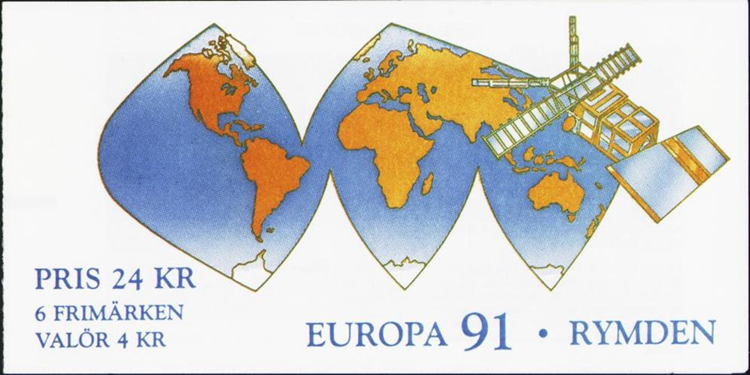The vision of satellite cooperation was followed up by the Nordic Industrial Fund (now Nordic Innovation), which initiated the Nordsat collaboration. Through this cooperation, the Nordic space industry received an energy boost and an influx of knowledge that has grown into a world-leading industry in several fields.
The idea of a joint Nordic TV Collaboration
The idea of a Nordic TV collaboration emerged as early as 1955. The proposal was for the Nordic countries to jointly expand the broadcasting network and produce joint programs, since the new medium was so costly. However, it was not until 1973 that a concrete recommendation on Nordic TV collaboration was adopted. This time, the goal was to strengthen cultural ties, increase language understanding between countries, reinforce Nordic identity, and reduce program imports from non-Nordic countries. Other European countries, such as Germany, France, and Luxembourg, were well underway in planning satellite broadcasting. As satellites were launched, Nordic TV viewers with antennas and reception equipment would be able to receive foreign broadcasts.
Nordic Industrial Fund (now Nordic Innovation) followed up on these visions and initiated the Nordsat collaboration, which consisted of a total of three reports. Research for the first report, on the technical and economic prerequisites for implementing satellite cooperation, began in 1975 with assistance from Svenska Rymdbolaget (now Swedish Space Corporation). In 1977, the report was completed, concluding that permanent satellite distribution of radio and TV in the Nordic countries was realistic and economically feasible.

Key players from the Nordic satellite industry
This first report laid the groundwork for collaboration between players in the Nordic satellite industry. A group called the Nordic Industrial Group for Nordsat – NIG was established, consisting of companies such as Saab, Ericsson, Nokia, Kongsberg Våpenfabrikk and Christian Rovsing. Many of these companies have greatly benefited from the satellite development that the Nordsat investigation facilitated.
The next step was to examine the cultural, program, technical, legal, and economic aspects of the proposals. The report, totaling 2000 pages, laid the foundation for the Nordic Council of Ministers' proposal in 1981 to initiate a Nordic satellite cooperation.
Nordic telecom satellite launch
The launch of the Nordic telecom satellite Tele-X from Kourou took place on 2 April 1989.
Many were positive about the plans. Among others, the NORDEN Association (Foreningen Norden) gave the project its full support, believing that "direct distribution of all TV programs could provide the population in the Nordic countries with good opportunities to follow each other's cultural and political life." The satellites were intended to orbit at such a high altitude that signals could reach Svalbard. At the time, TV viewers in Svalbard had to make do with watching Dagsrevyen and other programs 14 days after they were broadcasted on the mainland.
"If it should hail down upon us with American soap operas, Italian spaghetti westerns, Arabic news broadcasts, and Japanese horror films, and there should be nothing of interest on Norwegian TV, it would be good if we could switch to Denmark, Sweden, Finland, and Iceland." A fully commercial mass culture from the rest of the world would soon stream into people's living rooms regardless."
Aftenposten, Norway, 1982
However, Nordsat also faced significant opposition. Some concerns revolved around unresolved copyright issues and differing practices in advertising on TV broadcasts. Others were worried about children watching too much TV, people choosing more low-quality programs if given more choices, and people participating less in cultural activities.
The project was continually delayed, partly due to uncertainties around costs. The Nordsat project came to an end when Denmark withdrew in 1982. Collaboration around the TV satellite Tele-X continued with the other Nordic countries but was abandoned in 1988. The Nordic Council of Ministers concluded that there were "no prerequisites for achieving consensus on a permanent distribution of TV programs in the Nordic countries via direct satellite broadcasting.”

A boost for the Nordic satellite industry
Even though the Nordic collaboration collapsed, the Swedish industry moved forward with Tele-X, which was launched in 1989. Behind the satellite were key players in the Nordsat collaboration: Swedish Space Corporation and Saab Ericsson Space. Tele-X marked the first step in a new era of advanced telecommunications in the Nordic region and was in operation until 1998.
The Deputy Director of Saab Ericsson Space stated in 2003, "Without the boost that Nordsat created for the Nordic industry, we wouldn't be as big as we are today. It has given us the opportunity to work with major players in Europe. Our company is now a world leader in the manufacturing of a specific component in satellites."
From a starting point where we wanted to watch each other's TV broadcasts, satellites and related technology have become a central part of our infrastructure. We need satellites for communication, data, research, navigation, and defense, to name a few. The Nordic region's strategic geographical location and highly skilled population are significant competitive advantages. Today, within the ecosystem, you can find everything from large, internationally leading companies like Kongsberg Defence & Aerospace to research environments, industry organizations, and smaller start-ups. In Sweden, they have even established a dedicated Space High School.
Although the Nordsat collaboration failed, it remains an excellent example of how Nordic collaboration on innovation and knowledge acquisition in the early stages creates unforeseen results and values that companies continue to benefit from.
Facts
The satellite collaboration Nordsat was initiated by the Nordic Industry Fund (now Nordic Innovation) in the 1970s. The assignment came from the Nordic Council of Ministers. The project began as a collaboration to reduce economic costs related to TV broadcasts and to strengthen the cultural community in the Nordic region by having joint TV programs.
The communication and broadcasting satellite Tele-X was launched in 1989 from Kourou in French Guiana. The project was originally a joint Nordic venture but was eventually taken over by the Swedish industry.
Nordsat marked the beginning of what is now a competitive and academically strong Nordic space industry. The Nordic space activity is an essential part of the societal structure and security in all Nordic countries.
Background: 50 years and onwards
This article is produced as a part of Nordic Innovations 50 years anniversary. In 2023, we celebrate an era with Nordic collaboration and innovation by showcasing pieces of what we have co-created over the past 50 years.




